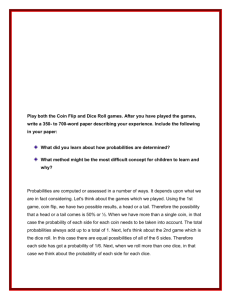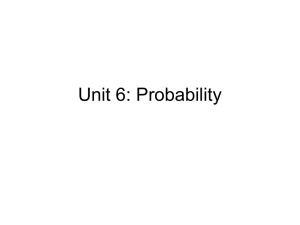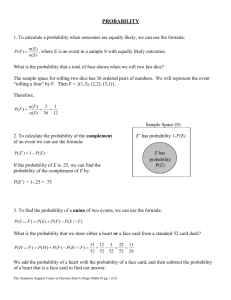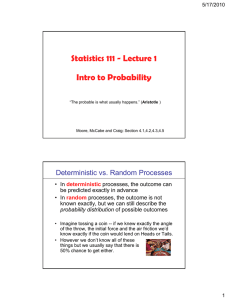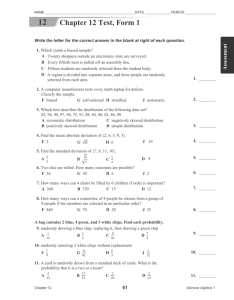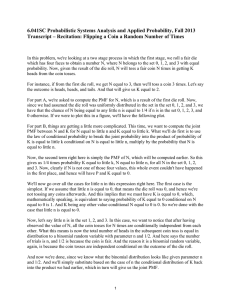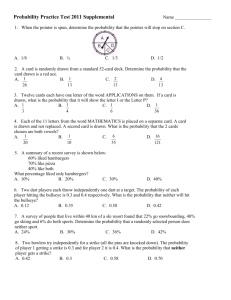STA 247 — Answers for practice problem set #1
advertisement
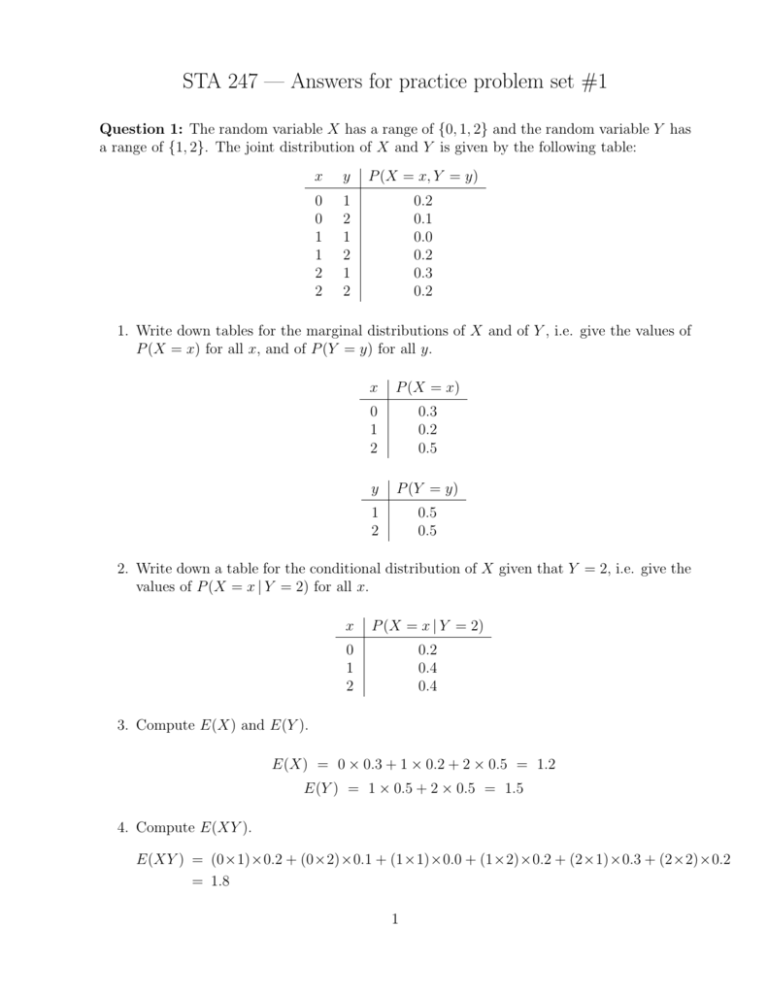
STA 247 — Answers for practice problem set #1
Question 1: The random variable X has a range of {0, 1, 2} and the random variable Y has
a range of {1, 2}. The joint distribution of X and Y is given by the following table:
x
y
P (X = x, Y = y)
0
0
1
1
2
2
1
2
1
2
1
2
0.2
0.1
0.0
0.2
0.3
0.2
1. Write down tables for the marginal distributions of X and of Y , i.e. give the values of
P (X = x) for all x, and of P (Y = y) for all y.
x
P (X = x)
0
1
2
0.3
0.2
0.5
y
P (Y = y)
1
2
0.5
0.5
2. Write down a table for the conditional distribution of X given that Y = 2, i.e. give the
values of P (X = x | Y = 2) for all x.
x
P (X = x | Y = 2)
0
1
2
0.2
0.4
0.4
3. Compute E(X) and E(Y ).
E(X) = 0 × 0.3 + 1 × 0.2 + 2 × 0.5 = 1.2
E(Y ) = 1 × 0.5 + 2 × 0.5 = 1.5
4. Compute E(XY ).
E(XY ) = (0×1)×0.2 + (0×2)×0.1 + (1×1)×0.0 + (1×2)×0.2 + (2×1)×0.3 + (2×2)×0.2
= 1.8
1
5. Are X and Y independent? Explain why or why not.
No, they are not independent, as can be seen from the fact that P (X = 1, Y = 1) 6=
P (X = 1)P (Y = 1). (The left side is 0, but the right side is 0.2 × 0.5 = 0.1.)
Note that the fact that E(XY ) = E(X)E(Y ) does NOT imply that X and Y are
independent. E(XY ) = E(X)E(Y ) is implied by X and Y being independent, but not
the other way around.
Question 2: You roll one red die and one green die. Define the random variables X and Y
as follows:
X = The number showing on the red die
Y
= The number of dice that show the number six
For example, if the red and green dice show the numbers 6 and 4, then X = 6 and Y = 1.
Write down a table showing the joint probability mass function for X and Y , find the
marginal distribution for Y , and compute E(Y ).
Here is a table showing the joint probability mass function, with the marginal distribution
for Y on the right:
X=
1
2
3
4
5
6
0 5/36 5/36 5/36 5/36 5/36
0
25/36
Y = 1 1/36 1/36 1/36 1/36 1/36 5/36 10/36
2
0
0
0
0
0
1/36 1/36
The expectation of Y is
E(Y ) = 0 × 25/36 + 1 × 10/36 + 2 × 1/36 = 12/36 = 1/3
Question 3. Suppose you roll two fair, six-sided dice, one of which is red and the other of
which is green. Define the following random variables:
X = The number shown on the red die
Y
0
= 1
2
if the two dice show the same number
if the number on the green die is bigger than the number on the red die
if the number on the red die is bigger than the number on the green die
a) Write down a table showing the joint probability mass function for X and Y .
X=
1
2
3
4
5
6
0 1/36 1/36 1/36 1/36 1/36 1/36
Y = 1 5/36 4/36 3/36 2/36 1/36
0
2
0
1/36 2/36 3/36 4/36 5/36
2
b) Find the marginal probability mass function for Y , and compute its expected value.
y
P (Y = y)
0
1
2
6/36
15/36
15/36
E(Y ) = 0 × (6/36) + 1 × (15/36) + 2 × (15/36) = 45/36
c) Find the conditional probability mass function for X given Y = 1.
1
5/15
2
4/15
X=
3
4
3/15 2/15
5
6
1/15 0
Question 4. You flip a fair coin. If the coin lands heads, you roll a fair six-sided die 100
times. If the coin lands tails, you roll the die 101 times. Let X be 1 if the coin lands heads
and 0 if the coin lands tails. Let Y be the total number of times that you roll a 6. Find
P (X = 1 | Y = 15).
We can find P (X = 1 | Y = 15) using Bayes’ Rule. It’s easiest using the “odds” form:
P (X = 1 | Y = 15)
P (X = 1)
P (Y = 15 | X = 1)
=
×
P (X = 0 | Y = 15)
P (X = 0)
P (Y = 15 | X = 0)
The ratio P (X = 1)/P (X = 0) is one, since heads and tails are equally likely.
The conditional probabilties P (Y = 15 | X = 1) and P (Y = 15 | X = 0) are both binomial.
Given X = 1, Y has the binomial distribution with n = 100 and p = 1/6, so
P (Y = 15 | X = 1) =
!
100
(1/6)15 (1−1/6)100−15
15
Given X = 0, Y has the binomial distribution with n = 101 and p = 1/6.
P (Y = 15 | X = 0) =
!
101
(1/6)15 (1−1/6)101−15
15
The odds for X = 1 given Y = 15 are therefore
P (X = 1 | Y = 15)
= 1×
P (X = 0 | Y = 15)
!
100
(1/6)15 (1−1/6)100−15
15
!
101
(1/6)15 (1−1/6)101−15
15
=
86
6
×
101 5
=
516
505
which gives P (X = 1 | Y = 15) = (516/505) / (1 + 516/505) = 0.505 . . .. (See the week 3
lecture summary regarding odds.)
3
Question 5. Suppose you randomly pick an integer from 1 to 3, with the three possibilities
being equally likely. Call this integer N . You then randomly pick an integer from N to 3,
with the 4 − N possibilities being equally likely. Call this second integer M . What is the
probability that M will be 3?
P (M = 3) =
3
X
P (M = 3, N = n)
3
X
P (M = 3 | N = n) P (N = n)
n=1
=
n=1
= (1/3) (1/3) + (1/2) (1/3) + 1 (1/3) = 11/18
Question 6. Three computers, A, B, and C, are linked by network connections as shown
below:
a1
A
a2
b1
B
b2
b3
C
Two network connections, a1 and a2, link computer A and computer B. Three network
connections, b1, b2, and b3, link computer B and computer C. Since there is no direct
connection from computer A to computer C, messages sent from computer A to computer C
must pass through computer B.
When computer A sends a message to computer B, it randomly chooses whether to use
connection a1 or connection a2, with probabilities of 2/3 for a1 and 1/3 for a2. When
computer B sends a message to computer C, it randomly chooses whether to use connection
b1, connection b2, or connection b3, with probabilities of 1/2 for b1, 1/4 for b2, and 1/4 for
b3.
The time to send a message through each connection is 1ms for a1, 2ms for a2, 1ms for b1,
2ms for b2, and 3ms for b3. When a message is sent from computer A to computer C through
computer B, it takes no time for computer B to take the message received from connection
a1 or a2 and send it on connection b1, b2, or b3.
Let X be the random variable whose value is the total time (in milliseconds) taken for a
message sent from computer A to computer C to arrive.
a) Find P (X = 4).
P (X = 4) = P (takes path a1, b3 or path a2, b2)
= P (takes path a1, b3) + P (takes path a2, b2)
= (2/3)(1/4) + (1/3)(1/4) = 1/4
4
b) Find E(X).
This can be found by finding the probabilities for all values of X, similarly to what is
done above for part (a), and then applying the definition of expectation.
It can more easily be solved by letting U be the time from A to B and V be the time
from B to C, so that X = U + V . Then E(X) = E(U ) + E(V ). We can compute that
E(U ) = 1 × (2/3) + 2 × (1/3) = 4/3 and E(V ) = 1 × (1/2) + 2 × (1/4) + 3 × (1/4) = 7/4.
So E(X) = (4/3) + (7/4) = 37/12.
c) Suppose that a message sent from computer A to computer C takes 4ms or more to
arrive (ie, X ≥ 4). How likely is it that this message was sent from computer B to
computer C using connection b3?
X ≥ 4 when the path taken is a1, b3 or a2, b2 or a2, b3. Of these, the paths a1, b3 and
a2, b3 involve connection b3. The conditional probability of b3 having been used given
that X ≥ 4 is therefore
P (path is a1, b3 or a2, b3)
(2/3)(1/4) + (1/3)(1/4)
3
=
=
P (path is a1, b3 or a2, b2 or a2, b3)
(2/3)(1/4) + (1/3)(1/4) + (1/3)(1/4)
4
5

